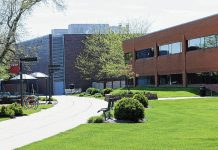Nearly 12,000 students from dozens of ethnic backgrounds speak 59 different languages across Bartholomew Consolidated School Corp.
While BCSC leaders said they celebrate the district’s diversity, they also concede that teaching students from varied backgrounds means overcoming barriers to learning, particularly language barriers.
That’s why BCSC has spent the past 10 years developing practices that allow students of different backgrounds to thrive academically.
In 2005, the BCSC Diversity Committee, led by director of secondary education Bill Jensen, began studying ways the district could address the unbalanced representation of different ethnic backgrounds in the district’s schools.
[sc:text-divider text-divider-title=”Story continues below gallery” ]
At that time, the vast majority of BCSC students were white — about 87.3 percent of the student population in 2006, according to the Indiana Department of Education.
Hispanic students held the next largest portion of the student body at about 4.7 percent.
Multiracial students made up the third largest percentage of BCSC students in 2006 — about 3.8 percent.
White and Hispanic students are still the most widely represented ethnic groups in Columbus schools for the 2015-16 school year, but with significant shifts in the proportionality.
While student enrollment as a whole has increased 7 percent in the past decade, the number of white students has dropped by 930 in that time and the number of Hispanic students has risen by 1,072.
White students now make up 73.6 percent of the student population, a 13.7 percentage point drop over 10 years.
Conversely, the Hispanic student population has grown to 13.6 percent of the total student population — an 8.9 percentage point increase.
Additionally, the number of Asian students — who made up only 2.1 percent of BCSC’s total student body in 2006 — has tripled in a decade’s time. Now representing 5.8 percent of student enrollment, Asian students have become the third largest ethnicity in the district.
BCSC leaders attribute the growth of the Hispanic and Asian populations in Columbus schools to the continued expansion of industrial businesses such as Cummins, Inc. and NTN Driveshaft. Workers often move with their families to Columbus from Spanish-speaking or Asian countries to take jobs in the local manufacturing industry, said John Quick, BCSC superintendent.
New teaching practices
As minority student populations continue to grow, district leaders have instituted instructional practices that are designed to work for all types of learners, including those who are not native English speakers.Specifically, all BCSC schools now use the Universal Design for Learning (UDL) method, which is designed to meet the needs of all types of learners through three principles of education:Multiple means of engagement, which focuses on motivating students
Multiple means of representation, which focuses on student comprehension
Multiple means of action and expression, which focuses on student goals
The UDL philosophy is meant to meet students where they are, regardless of any barriers to learning — including language, said Bill Jensen, director of secondary education.
Apart from general classroom practices, BCSC has also made improvements to its instructional methods targeted specifically to minority students.
When Quick first came to BCSC in 1991 as the principal of Taylorsville Elementary School, he said there were only two or three designated English Language Learners (ELL) instructors.
But today, the ELL staff is up to 50 people, with one teacher assigned specifically to Taylorsville and another to Clifty Creek Elementary School, which consistently have some of the largest Hispanic student populations in the district, Quick said.
Working through language barriers
English language instructors work with students who are not native English speakers in small groups to target certain areas of the curriculum where language barriers are impeding the learning process.Most students who are part of the English language classes are Hispanic, said Denise Recarte, BCSC’s ELL director. Japanese students make up the second highest percentage.When students first register at an Indiana school, they fill out a language survey that is used to determine which students will need to enroll in an English class, Recarte said.
Students are assessed to determine their language skills, then reassessed early in the spring semester to determine their progress in speaking, listening, reading and writing skills, Recarte said.
It’s important to assess students in all four of those areas because classroom performance can sometimes be misleading, Recarte said. A native Spanish speaker might be able to communicate well in English while in school but will struggle when asked to speak English in a non-classroom setting, she said.
Students must receive a score of 5.0 on a 1-5 proficiency level scale on the assessment before they can move out of formal English instruction and begin the monitoring phase, when teachers watch their progress to ensure their English skills do not wane.
Research shows that it takes an average of seven years for students to move completely through the ELL program, Recarte said.
The content that minority students learn in their language classes varies based on their prior experience with English, said Dana Schmidt, ELL instructor at Clifty Creek, which has a 22.3 percent Hispanic student population.
The instruction usually takes place during a time of day when other students are also receiving one-on-one help with their school work, not during large-group instruction, said Gina Pleak, Clifty Creek principal.
Sometimes language barriers extend beyond simple word definitions into larger cultural differences, said Sydell Gant, principal at Taylorsville, which is 38.2 percent Hispanic.
For example, a minority student who is not from the United States might struggle with the word “camping.”
In addition to not understanding the definition, Gant said minority students might not understand the American concept of camping, which could hinder their classroom experience when teachers read stories about camping.
ELL teachers use examples from students’ native languages and cultures to help them overcome that kind of confusion, Gant said.
“It takes a lot more explanation and physical and tangible examples to comprehend what the story is trying to have students learn,” she said.
Erin Cauble, the English language instructor at Taylorsville, said she often speaks Spanish when she works with Hispanic students early in the year to help them understand word concepts.
As the year goes on, she transitions to speaking predominantly in English, with a few Spanish words mixed into the lesson to ensure students understand what they’re learning.
Although language differences might impede the learning process, teachers say they do not affect the relationships students form in the classroom.
Pleak said English-speaking students at Clifty Creek often try to help their classmates who speak other languages understand what is happening in the classroom when language barriers get in the way.
At Taylorsville, Gant said the morning announcements are done in both English and Spanish, which has sparked an interest in learning Spanish among English-speaking students.




